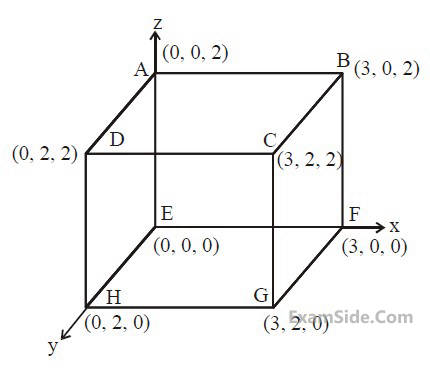Electrostatics · Physics · JEE Main
MCQ (Single Correct Answer)
Two metal spheres of radius R and 3R have same surface charge density σ. If they are brought in contact and then separated, the surface charge density on smaller and bigger sphere becomes σ1 and σ2, respectively. The ratio $ \frac{\sigma_1}{\sigma_2} $ is
Given below are two statements: one is labelled as Assertion $\mathbf{A}$ and the other is labelled as Reason $\mathbf{R}$
Assertion A : Work done in moving a test charge between two points inside a uniformly charged spherical shell is zero, no matter which path is chosen.
Reason R : Electrostatic potential inside a uniformly charged spherical shell is constant and is same as that on the surface of the shell.
In the light of the above statements, choose the correct answer from the options given below.
Electric charge is transferred to an irregular metallic disk as shown in the figure. If $\sigma_1$, $\sigma_2$, $\sigma_3$ and $\sigma_4$ are charge densities at given points then, choose the correct answer from the options given below:

A. $\sigma_1>\sigma_3 ; \sigma_2=\sigma_4$
B. $\sigma_1>\sigma_2 ; \sigma_3>\sigma_4$
C. $\sigma_1>\sigma_3>\sigma_2=\sigma_4$
D. $\sigma_1<\sigma_3<\sigma_2=\sigma_4$
E. $\sigma_1=\sigma_2=\sigma_3=\sigma_4$
An infinitely long wire has uniform linear charge density $\lambda = 2 \text{ nC/m}$. The net flux through a Gaussian cube of side length $\sqrt{3}$ cm, if the wire passes through any two corners of the cube, that are maximally displaced from each other, would be $x \text{ Nm}^2\text{C}^{-1}$, where $x$ is:
[Neglect any edge effects and use $\frac{1}{4\pi \epsilon_0} = 9 \times 10^9$ SI units]
A dipole with two electric charges of 2 µC magnitude each, with separation distance 0.5 µm, is placed between the plates of a capacitor such that its axis is parallel to an electric field established between the plates when a potential difference of 5 V is applied. Separation between the plates is 0.5 mm. If the dipole is rotated by 30° from the axis, it tends to realign in the direction due to a torque. The value of torque is:
Given below are two statements : one is labelled as Assertion (A) and the other is labelled as Reason (R).
Assertion (A) : The outer body of an aircraft is made of metal which protects persons sitting inside from lightning strikes.
Reason (R) : The electric field inside the cavity enclosed by a conductor is zero.
In the light of the above statements, choose the most appropriate answer from the options given below :
If $\epsilon_0$ denotes the permittivity of free space and $\Phi_E$ is the flux of the electric field through the area bounded by the closed surface, then dimensions of $\left(\epsilon_0 \frac{d \phi_E}{d t}\right)$ are that of :
Two charges $q_1$ and $q_2$ are separated by a distance of 30 cm . A third charge $q_3$ initially at ' C ' as shown in the figure, is moved along the circular path of radius 40 cm from C to D . If the difference in potential energy due to movement of $q_3$ from C to D is given by $\frac{q_3 \mathrm{~K}}{4 \pi \epsilon_0}$, the value of K is :

A metallic ring is uniformly charged as shown in figure. AC and BD are two mutually perpendicular diameters. Electric field due to arc $A B$ at ' $O$ ' is ' $E$ ' in magnitude. What would be the magnitude of electric field at ' O ' due to arc ABC ?

Two infinite identical charged sheets and a charged spherical body of charge density ' $\rho$ ' are arranged as shown in figure. Then the correct relation between the electrical fields at $\mathrm{A}, \mathrm{B}, \mathrm{C}$ and D points is:

Two small spherical balls of mass 10 g each with charges $-2 \mu \mathrm{C}$ and $2 \mu \mathrm{C}$, are attached to two ends of very light rigid rod of length 20 cm . The arrangement is now placed near an infinite nonconducting charge sheet with uniform charge density of $100 \mu \mathrm{C} / \mathrm{m}^2$ such that length of rod makes an angle of $30^{\circ}$ with electric field generated by charge sheet. Net torque acting on the rod is: (Take $\varepsilon_{\mathrm{o}}: 8.85 \times 10^{-12} \mathrm{C}^2 / \mathrm{Nm}^2$ )
The electrostatic potential on the surface of uniformly charged spherical shell of radius $\mathrm{R}=10 \mathrm{~cm}$ is 120 V . The potential at the centre of shell, at a distance $\mathrm{r}=5 \mathrm{~cm}$ from centre, and at a distance $\mathrm{r}=15$ cm from the centre of the shell respectively, are:
Given below are two statements : one is labelled as Assertion (A) and the other is labelled as Reason (R).
Assertion (A) : Net dipole moment of a polar linear isotropic dielectric substance is not zero even in the absence of an external electric field.
Reason (R) : In absence of an external electric field, the different permanent dipoles of a polar dielectric substance are oriented in random directions.
In the light of the above statements, choose the most appropriate answer from the options given below :

Consider two infinitely large plane parallel conducting plates as shown below. The plates are uniformly charged with a surface charge density $+\sigma$ and $-2 \sigma$. The force experienced by a point charge +q placed at the mid point between two plates will be:

A point charge $+q$ is placed at the origin. A second point charge $+9 q$ is placed at ($\mathrm{d}, 0,0$) in Cartesian coordinate system. The point in between them where the electric field vanishes is:
A small bob of mass 100 mg and charge $+10 \mu \mathrm{C}$ is connected to an insulating string of length 1 m . It is brought near to an infinitely long non-conducting sheet of charge density ' $\sigma$ ' as shown in figure. If string subtends an angle of $45^{\circ}$ with the sheet at equilibrium the charge density of sheet will be.
(Given, $\epsilon_0=8.85 \times 10^{-12} \frac{\mathrm{~F}}{\mathrm{~m}}$ and acceleration due to gravity, $\mathrm{g}=10 \frac{\mathrm{~m}}{\mathrm{~s}^2}$ )

A point charge causes an electric flux of $-2 \times 10^4 \mathrm{Nm}^2 \mathrm{C}^{-1}$ to pass through a spherical Gaussian surface of 8.0 cm radius, centred on the charge. The value of the point charge is :
(Given $\epsilon_0=8.85 \times 10^{-12} \mathrm{C}^2 \mathrm{~N}^{-1} \mathrm{~m}^{-2}$ )
An electric dipole is placed at a distance of 2 cm from an infinite plane sheet having positive charge density $\sigma_{\mathrm{o}}$. Choose the correct option from the following.
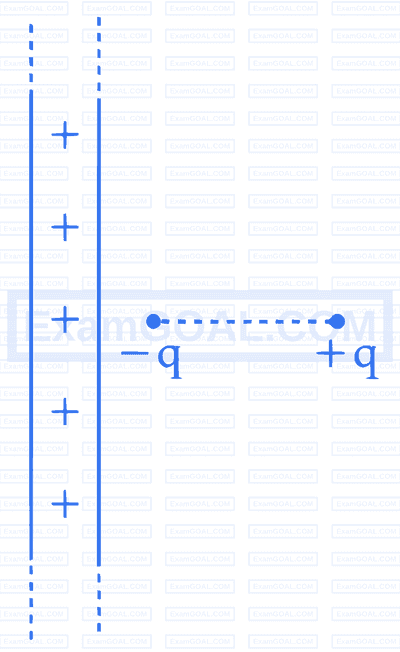
An electric dipole of mass $m$, charge $q$, and length $l$ is placed in a uniform electric field $\vec{E} = E_0\hat{i}$. When the dipole is rotated slightly from its equilibrium position and released, the time period of its oscillations will be :
Match List - I with List - II.
| List - I | List - II |
|---|---|
| (A) Electric field inside (distance r > 0 from center) of a uniformly charged spherical shell with surface charge density σ, and radius R. | (I) σ/ε0 |
| (B) Electric field at distance r>0 from a uniformly charged infinite plane sheet with surface charge density σ. | (II) σ/2ε0 |
| (C) Electric field outside (distance r>0 from center) of a uniformly charged spherical shell with surface charge density σ, and radius R. | (III) 0 |
| (D) Electric field between 2 oppositely charged infinite plane parallel sheets with uniform surface charge density σ. | (IV) $\frac{\sigma}{\epsilon_0 r^2}$ |
Choose the correct answer from the options given below :
Three infinitely long wires with linear charge density $\lambda$ are placed along the $x-a x i s, y-a x i s$ and $z-$ axis respectively. Which of the following denotes an equipotential surface?
A particle of mass ' $m$ ' and charge ' $q$ ' is fastened to one end ' $A$ ' of a massless string having equilibrium length $l$, whose other end is fixed at point ' $O$ '. The whole system is placed on a frictionless horizontal plane and is initially at rest. If uniform electric field is switched on along the direction as shown in figure, then the speed of the particle when it crosses the $x$-axis is

A small uncharged conducting sphere is placed in contact with an identical sphere but having $4 \times 10^{-8} \mathrm{C}$ charge and then removed to a distance such that the force of repulsion between them is $9 \times 10^{-3} \mathrm{~N}$. The distance between them is (Take $\frac{1}{4 \pi \epsilon_{\mathrm{o}}}$ as $9 \times 10^9$ in SI units)

In the first configuration (1) as shown in the figure, four identical charges $\left(q_0\right)$ are kept at the corners A, B, C and D of square of side length ' $a$ '. In the second configuration (2), the same charges are shifted to mid points $G, E, H$ and $F$, of the square. If $K=\frac{1}{4 \pi \epsilon_0}$, the difference between the potential energies of configuration (2) and (1) is given by :
Consider a parallel plate capacitor of area A (of each plate) and separation ' $d$ ' between the plates. If $E$ is the electric field and $\varepsilon_0$ is the permittivity of free space between the plates, then potential energy stored in the capacitor is
Two point charges $-4 \mu \mathrm{c}$ and $4 \mu \mathrm{c}$, constituting an electric dipole, are placed at $(-9,0,0) \mathrm{cm}$ and $(9,0,0) \mathrm{cm}$ in a uniform electric field of strength $10^4 \mathrm{NC}^{-1}$. The work done on the dipole in rotating it from the equilibrium through $180^{\circ}$ is :
Two charges $7 \mu \mathrm{c}$ and $-4 \mu \mathrm{c}$ are placed at $(-7 \mathrm{~cm}, 0,0)$ and $(7 \mathrm{~cm}, 0,0)$ respectively. Given, $\epsilon_0=8.85 \times 10^{-12} \mathrm{C}^2 \mathrm{~N}^{-1} \mathrm{~m}^{-2}$, the electrostatic potential energy of the charge configuration is :
A point particle of charge $Q$ is located at $P$ along the axis of an electric dipole 1 at a distance $r$ as shown in the figure. The point P is also on the equatorial plane of a second electric dipole 2 at a distance r. The dipoles are made of opposite charge q separated by a distance $2 a$. For the charge particle at P not to experience any net force, which of the following correctly describes the situation?

The electric flux is $\phi=\alpha \sigma+\beta \lambda$ where $\lambda$ and $\sigma$ are linear and surface charge density, respectively. $\left(\frac{\alpha}{\beta}\right)$ represents
For a short dipole placed at origin O , the dipole moment P is along $x$-axis, as shown in the figure. If the electric potential and electric field at $A$ are $V_0$ and $E_0$, respectively, then the correct combination of the electric potential and electric field, respectively, at point B on the $y$-axis is given by

A line charge of length $\frac{\mathrm{a}}{2}$ is kept at the center of an edge $B C$ of a cube ABCDEFGH having edge length ' $a$ ' as shown in the figure. If the density of line charge is $\lambda \mathrm{C}$ per unit length, then the total electric flux through all the faces of the cube will be ___________ . (Take, $\epsilon_0$ as the free space permittivity)

Five charges $$+q,+5 q,-2 q,+3 q$$ and $$-4 q$$ are situated as shown in the figure. The electric flux due to this configuration through the surface $$S$$ is :

Two charged conducting spheres of radii $$a$$ and $$b$$ are connected to each other by a conducting wire. The ratio of charges of the two spheres respectively is:
Two identical conducting spheres P and S with charge Q on each, repel each other with a force $$16 \mathrm{~N}$$. A third identical uncharged conducting sphere $$\mathrm{R}$$ is successively brought in contact with the two spheres. The new force of repulsion between $$\mathrm{P}$$ and $$\mathrm{S}$$ is :
$$\sigma$$ is the uniform surface charge density of a thin spherical shell of radius R. The electric field at any point on the surface of the spherical shell is :
The vehicles carrying inflammable fluids usually have metallic chains touching the ground:
In hydrogen like system the ratio of coulombian force and gravitational force between an electron and a proton is in the order of :
A charge $$q$$ is placed at the center of one of the surface of a cube. The flux linked with the cube is:
An infinitely long positively charged straight thread has a linear charge density $$\lambda \mathrm{~Cm}^{-1}$$. An electron revolves along a circular path having axis along the length of the wire. The graph that correctly represents the variation of the kinetic energy of electron as a function of radius of circular path from the wire is :

Force between two point charges $$q_1$$ and $$q_2$$ placed in vacuum at '$$r$$' cm apart is $$F$$. Force between them when placed in a medium having dielectric constant $$K=5$$ at '$$r / 5$$' $$\mathrm{cm}$$ apart will be:
Two charges $$q$$ and $$3 q$$ are separated by a distance '$$r$$' in air. At a distance $$x$$ from charge $$q$$, the resultant electric field is zero. The value of $$x$$ is :
A particle of charge '$$-q$$' and mass '$$m$$' moves in a circle of radius '$$r$$' around an infinitely long line charge of linear charge density '$$+\lambda$$'. Then time period will be given as :
(Consider $$k$$ as Coulomb's constant)
The electrostatic potential due to an electric dipole at a distance '$$r$$' varies as :
An electric field is given by $$(6 \hat{i}+5 \hat{j}+3 \hat{k}) \mathrm{N} / \mathrm{C}$$. The electric flux through a surface area $$30 \hat{i} \mathrm{~m}^2$$ lying in YZ-plane (in SI unit) is :
Two charges of $$5 Q$$ and $$-2 Q$$ are situated at the points $$(3 a, 0)$$ and $$(-5 a, 0)$$ respectively. The electric flux through a sphere of radius '$$4 a$$' having center at origin is :
Given below are two statements : one is labelled as Assertion (A) and the other is labelled as Reason (R).
Assertion (A) : Work done by electric field on moving a positive charge on an equipotential surface is always zero.
Reason (R) : Electric lines of forces are always perpendicular to equipotential surfaces.
In the light of the above statements, choose the most appropriate answer from the options given below :
An electric charge $$10^{-6} \mu \mathrm{C}$$ is placed at origin $$(0,0)$$ $$\mathrm{m}$$ of $$\mathrm{X}-\mathrm{Y}$$ co-ordinate system. Two points $$\mathrm{P}$$ and $$\mathrm{Q}$$ are situated at $$(\sqrt{3}, \sqrt{3}) \mathrm{m}$$ and $$(\sqrt{6}, 0) \mathrm{m}$$ respectively. The potential difference between the points $\mathrm{P}$ and $\mathrm{Q}$ will be :
A $$10 ~\mu \mathrm{C}$$ charge is divided into two parts and placed at $$1 \mathrm{~cm}$$ distance so that the repulsive force between them is maximum. The charges of the two parts are:
Two charges each of magnitude $$0.01 ~\mathrm{C}$$ and separated by a distance of $$0.4 \mathrm{~mm}$$ constitute an electric dipole. If the dipole is placed in an uniform electric field '$$\vec{E}$$' of 10 dyne/C making $$30^{\circ}$$ angle with $$\vec{E}$$, the magnitude of torque acting on dipole is:
Given below are two statements: one is labelled as Assertion A and the other is labelled as Reason R
Assertion A : If an electric dipole of dipole moment $$30 \times 10^{-5} ~\mathrm{C} ~\mathrm{m}$$ is enclosed by a closed surface, the net flux coming out of the surface will be zero.
Reason R : Electric dipole consists of two equal and opposite charges.
In the light of above, statements, choose the correct answer from the options given below.
In a metallic conductor, under the effect of applied electric field, the free electrons of the conductor
Electric potential at a point '$$\mathrm{P}$$' due to a point charge of $$5 \times 10^{-9} \mathrm{C}$$ is $$50 \mathrm{~V}$$. The distance of '$$\mathrm{P}$$' from the point charge is:
(Assume, $$\frac{1}{4 \pi \varepsilon_{0}}=9 \times 10^{+9} ~\mathrm{Nm}^{2} \mathrm{C}^{-2}$$ )
Graphical variation of electric field due to a uniformly charged insulating solid sphere of radius $$\mathrm{R}$$, with distance $$r$$ from the centre O is represented by:

A dipole comprises of two charged particles of identical magnitude $$q$$ and opposite in nature. The mass 'm' of the positive charged particle is half of the mass of the negative charged particle. The two charges are separated by a distance '$$l$$'. If the dipole is placed in a uniform electric field '$$\bar{E}$$'; in such a way that dipole axis makes a very small angle with the electric field, '$$\bar{E}$$'. The angular frequency of the oscillations of the dipole when released is given by:
For a uniformly charged thin spherical shell, the electric potential (V) radially away from the centre (O) of shell can be graphically represented as -

Let $$\sigma$$ be the uniform surface charge density of two infinite thin plane sheets shown in figure. Then the electric fields in three different region $$E_{I}, E_{I I}$$ and $$E_{I I I}$$ are:

Which of the following correctly represents the variation of electric potential $$(\mathrm{V})$$ of a charged spherical conductor of radius $$(\mathrm{R})$$ with radial distance $$(\mathrm{r})$$ from the center?
$(\mathrm{I}: r < a, \mathrm{II}: a < r < b$, III: $r>b$ )
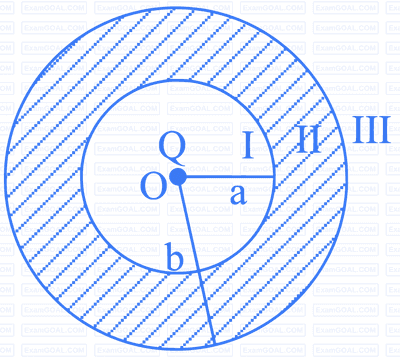
Electric field in a certain region is given by $$\overrightarrow{\mathrm{E}}=\left(\frac{\mathrm{A}}{x^{2}} \hat{i}+\frac{\mathrm{B}}{y^{3}} \hat{j}\right) \text {. The } \mathrm{SI} \text { unit of } \mathrm{A} \text { and } \mathrm{B}$$ are :
Two isolated metallic solid spheres of radii $$\mathrm{R}$$ and $$2 \mathrm{R}$$ are charged such that both have same charge density $$\sigma$$. The spheres are then connected by a thin conducting wire. If the new charge density of the bigger sphere is $$\sigma^{\prime}$$. The ratio $$\frac{\sigma^{\prime}}{\sigma}$$ is :
A point charge $$2\times10^{-2}~\mathrm{C}$$ is moved from P to S in a uniform electric field of $$30~\mathrm{NC^{-1}}$$ directed along positive x-axis. If coordinates of P and S are (1, 2, 0) m and (0, 0, 0) m respectively, the work done by electric field will be
In a cuboid of dimension $$2 \mathrm{~L} \times 2 \mathrm{~L} \times \mathrm{L}$$, a charge $$q$$ is placed at the center of the surface '$$\mathrm{S}$$' having area of $$4 \mathrm{~L}^{2}$$. The flux through the opposite surface to '$$\mathrm{S}$$' is given by
A point charge of 10 $$\mu$$C is placed at the origin. At what location on the X-axis should a point charge of 40 $$\mu$$C be placed so that the net electric field is zero at $$x=2$$cm on the X-axis?
The electric potential at the centre of two concentric half rings of radii R$$_1$$ and R$$_2$$, having same linear charge density $$\lambda$$ is :

If two charges q$$_1$$ and q$$_2$$ are separated with distance 'd' and placed in a medium of dielectric constant K. What will be the equivalent distance between charges in air for the same electrostatic force?
Two identical metallic spheres $$\mathrm{A}$$ and $$\mathrm{B}$$ when placed at certain distance in air repel each other with a force of $$\mathrm{F}$$. Another identical uncharged sphere $$\mathrm{C}$$ is first placed in contact with $$\mathrm{A}$$ and then in contact with $$\mathrm{B}$$ and finally placed at midpoint between spheres A and B. The force experienced by sphere C will be:
A spherically symmetric charge distribution is considered with charge density varying as
$$\rho(r)= \begin{cases}\rho_{0}\left(\frac{3}{4}-\frac{r}{R}\right) & \text { for } r \leq R \\ \text { zero } & \text { for } r>R\end{cases}$$
Where, $$r(r < R)$$ is the distance from the centre O (as shown in figure). The electric field at point P will be:

Given below are two statements.
Statement I : Electric potential is constant within and at the surface of each conductor.
Statement II : Electric field just outside a charged conductor is perpendicular to the surface of the conductor at every point.
In the light of the above statements, choose the most appropriate answer from the options given below.
A uniform electric field $$\mathrm{E}=(8 \mathrm{~m} / \mathrm{e}) \,\mathrm{V} / \mathrm{m}$$ is created between two parallel plates of length $$1 \mathrm{~m}$$ as shown in figure, (where $$\mathrm{m}=$$ mass of electron and e = charge of electron). An electron enters the field symmetrically between the plates with a speed of $$2 \mathrm{~m} / \mathrm{s}$$. The angle of the deviation $$(\theta)$$ of the path of the electron as it comes out of the field will be _________.

A charge of $$4 \,\mu \mathrm{C}$$ is to be divided into two. The distance between the two divided charges is constant. The magnitude of the divided charges so that the force between them is maximum, will be :
Two identical positive charges $$Q$$ each are fixed at a distance of '2a' apart from each other. Another point charge $$q_{0}$$ with mass 'm' is placed at midpoint between two fixed charges. For a small displacement along the line joining the fixed charges, the charge $$\mathrm{q}_{0}$$ executes $$\mathrm{SHM}$$. The time period of oscillation of charge $$\mathrm{q}_{0}$$ will be :
Two uniformly charged spherical conductors $$A$$ and $$B$$ of radii $$5 \mathrm{~mm}$$ and $$10 \mathrm{~mm}$$ are separated by a distance of $$2 \mathrm{~cm}$$. If the spheres are connected by a conducting wire, then in equilibrium condition, the ratio of the magnitudes of the electric fields at the surface of the sphere $$A$$ and $$B$$ will be :
Two point charges Q each are placed at a distance d apart. A third point charge q is placed at a distance x from mid-point on the perpendicular bisector. The value of x at which charge q will experience the maximum Coulomb's force is :
If the electric potential at any point (x, y, z) m in space is given by V = 3x2 volt. The electric field at the point (1, 0, 3) m will be :
A positive charge particle of 100 mg is thrown in opposite direction to a uniform electric field of strength 1 $$\times$$ 105 NC$$-$$1. If the charge on the particle is 40 $$\mu$$C and the initial velocity is 200 ms$$-$$1, how much distance it will travel before coming to the rest momentarily :
Two point charges A and B of magnitude +8 $$\times$$ 10$$-$$6 C and $$-$$8 $$\times$$ 10$$-$$6 C respectively are placed at a distance d apart. The electric field at the middle point O between the charges is 6.4 $$\times$$ 104 NC$$-$$1. The distance 'd' between the point charges A and B is :
Given below are two statements :
Statement I : A point charge is brought in an electric field. The value of electric field at a point near to the charge may increase if the charge is positive.
Statement II : An electric dipole is placed in a non-uniform electric field. The net electric force on the dipole will not be zero.
Choose the correct answer from the options given below :
The three charges q/2, q and q/2 are placed at the corners A, B and C of a square of side 'a' as shown in figure. The magnitude of electric field (E) at the corner D of the square, is :

If a charge q is placed at the centre of a closed hemispherical non-conducting surface, the total flux passing through the flat surface would be :

Three identical charged balls each of charge 2 C are suspended from a common point P by silk threads of 2 m each (as shown in figure). They form an equilateral triangle of side 1m.
The ratio of net force on a charged ball to the force between any two charged balls will be :

Sixty four conducting drops each of radius 0.02 m and each carrying a charge of 5 $$\mu$$C are combined to form a bigger drop. The ratio of surface density of bigger drop to the smaller drop will be :
Given below two statements : One is labelled as Assertion (A) and other is labelled as Reason (R).
Assertion (A) : Non-polar materials do not have any permanent dipole moment.
Reason (R) : When a non-polar material is placed in an electric field, the centre of the positive charge distribution of it's individual atom or molecule coincides with the centre of the negative charge distribution.
In the light of above statements, choose the most appropriate answer from the options given below.
In the figure, a very large plane sheet of positive charge is shown. P1 and P2 are two points at distance l and 2l from the charge distribution. If $$\sigma$$ is the surface charge density, then the magnitude of electric fields E1 and E2 at P1 and P2 respectively are :

Two identical charged particles each having a mass 10 g and charge 2.0 $$\times$$ 10$$-$$7C are placed on a horizontal table with a separation of L between them such that they stay in limited equilibrium. If the coefficient of friction between each particle and the table is 0.25, find the value of L. [Use g = 10 ms$$-$$2]
A long cylindrical volume contains a uniformly distributed charge of density $$\rho$$. The radius of cylindrical volume is R. A charge particle (q) revolves around the cylinder in a circular path. The kinetic energy of the particle is :
A vertical electric field of magnitude 4.9 $$\times$$ 105 N/C just prevents a water droplet of a mass 0.1 g from falling. The value of charge on the droplet will be :
(Given : g = 9.8 m/s2)

(1) The electric lines of force entering into a Gaussian surface provide negative flux.
(2) A charge 'q' is placed at the centre of a cube. The flux through all the faces will be the same.
(3) In a uniform electric field net flux through a closed Gaussian surface containing no net charge, is zero.
(4) When electric field is parallel to a Gaussian surface, it provides a finite non-zero flux.
Choose the most appropriate answer from the options given below

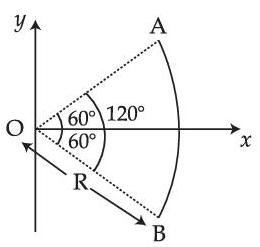



Statement I : An electric dipole is placed at the center of a hollow sphere. The flux of the electric field through the sphere is zero but the electric field is not zero anywhere in the sphere.
Statement II : If R is the radius of a solid metallic sphere and Q be the total charge on it. The electric field at any point on the spherical surface of radius r (< R) is zero but the electric flux passing through this closed spherical surface of radius r is not zero..
In the light of the above statements, choose the correct answer from the options given below :
[g = 9.8 m/s2; $$\sin 30^\circ = {1 \over 2}$$; $$\cos 30^\circ = {{\sqrt 3 } \over 2}$$]




$${{{Q_1}} \over {{Q_2}}}$$ is proportional to :

(Take V = 0 at infinity)
(assume the remaining portion to be spherical).
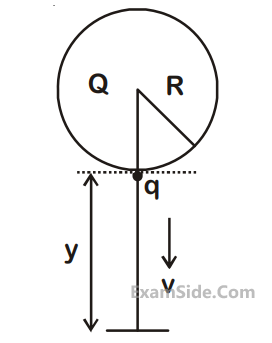
E = E0 (1 – $$a$$x2) in the x-direction, where $$a$$ and E0 are constants. Initially the particle was at rest at x = 0. Other than the initial position the kinetic energy of the particle becomes zero when the distance of the particle from the origin is :

uniform surface charge density $${\sigma _ + }$$ and $${\sigma _ - }$$,
where |$${\sigma _ + }$$| > |$${\sigma _ - }$$|, intersect at right angle.
Which of the following best represents the
electric field lines for this system :
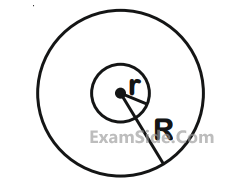
(Curves are drawn schematically and are not to scale).
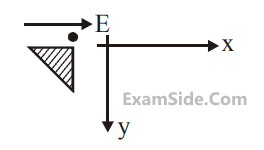
moves along X-axis with velocity V0. When it
passes through the origin it enters a region having uniform electric field
$$\overrightarrow E = - E\widehat j$$ which extends upto x = d.
Equation of path of electron in the region x > d is
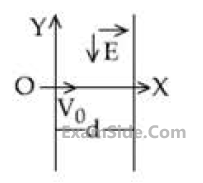

$$\overrightarrow p = \left( { - \widehat i - 3\widehat j + 2\widehat k} \right) \times {10^{ - 29}} $$ C.m is
at the origin (0, 0, 0). The electric field due to this dipole at
$$\overrightarrow r = + \widehat i + 3\widehat j + 5\widehat k$$ (note that $$\overrightarrow r .\overrightarrow p = 0$$ ) is parallel to :


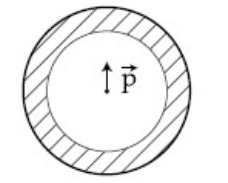
 If D >> d, the potential energy of the system is
best given by :
If D >> d, the potential energy of the system is
best given by :
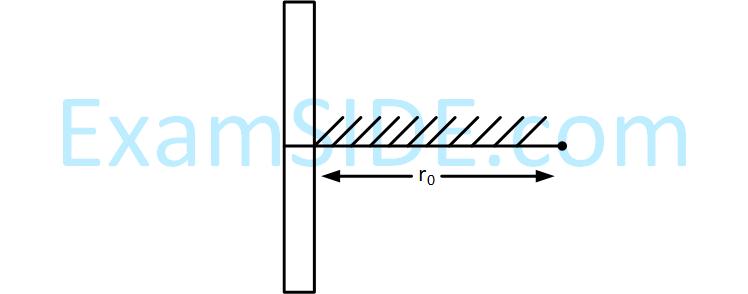





[take $${1 \over {4\pi { \in _0}}}$$ = 9 $$ \times $$ 109 Nm2C$$-$$2]
given by $$\rho $$ = $$\rho $$o (1 $$-$$ $${\raise0.5ex\hbox{$\scriptstyle r$} \kern-0.1em/\kern-0.15em \lower0.25ex\hbox{$\scriptstyle R$}}$$) for 0 $$ \le $$ r $$ \le $$ R. The electric field outside the ball is :

The electric flux through the square surface is

Let the respective electric fluxes through the surfaces be $${\Phi _1},$$ $${\Phi _2},$$ $${\Phi _3}$$ and $${\Phi _4}$$. Then :
V(z) = 30 $$-$$ 5x2 for $$\left| z \right|$$ $$ \le $$ 1 m.
V(z) = 35 $$-$$ 10 $$\left| z \right|$$ for $$\left| z \right|$$ $$ \ge $$1 m.
V(z) does not depend on x and y. If this potential is generated by a constant charge per unit volume $${\rho _0}$$ (in units of $${\varepsilon _0}$$) which is spread over a certain region, then choose the correct statement.

(figures are schematic and not drawn to scale)

An insulating solid sphere of radius $$R$$ has a uniformly positive charge density $$\rho $$. As a result of this uniform charge distribution there is a finite value of electric potential at the center of the sphere, at the surface of the sphere and also at a point out side the sphere. The electric potential at infinite is zero.
Statement- $$1:$$ When a charge $$q$$ is take from the centre of the surface of the sphere its potential energy changes by $${{q\rho } \over {3{\varepsilon _0}}}$$
Statement- $$2:$$ The electric field at a distance $$r\left( {r < R} \right)$$ from the center of the sphere is $${{\rho r} \over {3{\varepsilon _0}}}.$$

Statement-1 : For a charged particle moving from point $$P$$ to point $$Q$$, the net work done by an electrostatic field on the particle is independent of the path connecting point $$P$$ to point $$Q.$$
Statement-2 : The net work done by a conservative force on an object moving along a closed loop is zero.

The electric field $$E$$ at $$x = 4\,\mu \,m$$ is given by
$$\left( {e = 1.6 \times {{10}^{ - 19}}\,C,\,\,{m_e} = 9.11 \times {{10}^{ - 31}}\,kg} \right)$$

 f
f 

Numerical
A square loop of sides $a=1 \mathrm{~m}$ is held normally in front of a point charge $\mathrm{q}=1 \mathrm{C}$ at a distance $\frac{\mathrm{a}}{2}$. The flux of the electric field through the shaded region is $\frac{5}{\mathrm{p}} \times \frac{1}{\varepsilon_0} \frac{\mathrm{Nm}^2}{\mathrm{C}}$, where the value of p is ________ .

A positive ion $A$ and a negative ion $B$ has charges $6.67 \times 10^{-19} \mathrm{C}$ and $9.6 \times 10^{-10} \mathrm{C}$, and masses $19.2 \times 10^{-27} \mathrm{~kg}$ and $9 \times 10^{-27} \mathrm{~kg}$ respectively. At an instant, the ions are separated by a certain distance $r$. At that instant the ratio of the magnitudes of electrostatic force to gravitational force is $\mathrm{P} \times 10^{-13}$, where the value of P is _________.
(Take $\frac{1}{4 \pi \varepsilon_0}=9 \times 10^9 \mathrm{Nm}^2 \mathrm{C}^{-1}$ and universal gravitational constant as $6.67 \times 10^{-11} \mathrm{Nm}^2 \mathrm{~kg}^{-2}$ )
An electric field $$\vec{E}=(2 x \hat{i}) N C^{-1}$$ exists in space. A cube of side $$2 \mathrm{~m}$$ is placed in the space as per figure given below. The electric flux through the cube is ______ $$\mathrm{Nm}^2 / \mathrm{C}$$.

At the centre of a half ring of radius $$\mathrm{R}=10 \mathrm{~cm}$$ and linear charge density $$4 \mathrm{~nC} \mathrm{~m}^{-1}$$, the potential is $$x \pi \mathrm{V}$$. The value of $$x$$ is _________.
If the net electric field at point $$\mathrm{P}$$ along $$\mathrm{Y}$$ axis is zero, then the ratio of $$\left|\frac{q_2}{q_3}\right|$$ is $$\frac{8}{5 \sqrt{x}}$$, where $$x=$$ ________.

An electric field, $$\overrightarrow{\mathrm{E}}=\frac{2 \hat{i}+6 \hat{j}+8 \hat{k}}{\sqrt{6}}$$ passes through the surface of $$4 \mathrm{~m}^2$$ area having unit vector $$\hat{n}=\left(\frac{2 \hat{i}+\hat{j}+\hat{k}}{\sqrt{6}}\right)$$. The electric flux for that surface is _________ $$\mathrm{Vm}$$.
Three infinitely long charged thin sheets are placed as shown in figure. The magnitude of electric field at the point $$P$$ is $$\frac{x \sigma}{\epsilon_0}$$. The value of $$x$$ is _________ (all quantities are measured in SI units).

The electric field at point $$\mathrm{p}$$ due to an electric dipole is $$\mathrm{E}$$. The electric field at point $$\mathrm{R}$$ on equitorial line will be $$\frac{\mathrm{E}}{x}$$. The value of $$x$$ :

An infinite plane sheet of charge having uniform surface charge density $$+\sigma_{\mathrm{s}} \mathrm{C} / \mathrm{m}^2$$ is placed on $$x$$-$$y$$ plane. Another infinitely long line charge having uniform linear charge density $$+\lambda_e \mathrm{C} / \mathrm{m}$$ is placed at $$z=4 \mathrm{~m}$$ plane and parallel to $$y$$-axis. If the magnitude values $$\left|\sigma_{\mathrm{s}}\right|=2\left|\lambda_{\mathrm{e}}\right|$$ then at point $$(0,0,2)$$, the ratio of magnitudes of electric field values due to sheet charge to that of line charge is $$\pi \sqrt{n}: 1$$. The value of $$n$$ is _________.
Then the charge on the particle will be $\frac{1}{\sqrt{x}} \mu \mathrm{C}$ where $x=$ ___________ . [use $\mathrm{g}=10 \mathrm{~m} / \mathrm{s}^2$ ]
(Take density of water $=1 \mathrm{~g} / \mathrm{cc}$ )
The distance between charges $$+q$$ and $$-q$$ is $$2 l$$ and between $$+2 q$$ and $$-2 q$$ is $$4 l$$. The electrostatic potential at point $$P$$ at a distance $$r$$ from center $$O$$ is $$-\alpha\left[\frac{q l}{r^2}\right] \times 10^9 \mathrm{~V}$$, where the value of $$\alpha$$ is __________. (Use $$\frac{1}{4 \pi \varepsilon_0}=9 \times 10^9 \mathrm{~Nm}^2 \mathrm{C}^{-2}$$)

Two identical charged spheres are suspended by strings of equal lengths. The strings make an angle of $$37^{\circ}$$ with each other. When suspended in a liquid of density $$0.7 \mathrm{~g} / \mathrm{cm}^3$$, the angle remains same. If density of material of the sphere is $$1.4 \mathrm{~g} / \mathrm{cm}^3$$, the dielectric constant of the liquid is _______ $$\left(\tan 37^{\circ}=\frac{3}{4}\right)$$
An electron is moving under the influence of the electric field of a uniformly charged infinite plane sheet $$\mathrm{S}$$ having surface charge density $$+\sigma$$. The electron at $$t=0$$ is at a distance of $$1 \mathrm{~m}$$ from $$S$$ and has a speed of $$1 \mathrm{~m} / \mathrm{s}$$. The maximum value of $$\sigma$$ if the electron strikes $$S$$ at $$t=1 \mathrm{~s}$$ is $$\alpha\left[\frac{m \epsilon_0}{e}\right] \frac{C}{m^2}$$, the value of $$\alpha$$ is ___________.
Two charges of $$-4 \mu \mathrm{C}$$ and $$+4 \mu \mathrm{C}$$ are placed at the points $$\mathrm{A}(1,0,4) \mathrm{m}$$ and $$\mathrm{B}(2,-1,5) \mathrm{m}$$ located in an electric field $$\overrightarrow{\mathrm{E}}=0.20 \hat{i} \mathrm{~V} / \mathrm{cm}$$. The magnitude of the torque acting on the dipole is $$8 \sqrt{\alpha} \times 10^{-5} \mathrm{Nm}$$, where $$\alpha=$$ _________.
The electric potential at the surface of an atomic nucleus $$(z=50)$$ of radius $$9 \times 10^{-13} \mathrm{~cm}$$ is __________ $$\times 10^6 \mathrm{~V}$$.
A thin metallic wire having cross sectional area of $$10^{-4} \mathrm{~m}^2$$ is used to make a ring of radius $$30 \mathrm{~cm}$$. A positive charge of $$2 \pi \mathrm{~C}$$ is uniformly distributed over the ring, while another positive charge of 30 $$\mathrm{pC}$$ is kept at the centre of the ring. The tension in the ring is ______ $$\mathrm{N}$$; provided that the ring does not get deformed (neglect the influence of gravity). (given, $$\frac{1}{4 \pi \epsilon_0}=9 \times 10^9$$ SI units)
Three point charges $$\mathrm{q},-2 \mathrm{q}$$ and $$2 \mathrm{q}$$ are placed on $x$-axis at a distance $$x=0, x=\frac{3}{4} R$$ and $$x=R$$ respectively from origin as shown. If $$\mathrm{q}=2 \times 10^{-6} \mathrm{C}$$ and $$\mathrm{R}=2 \mathrm{~cm}$$, the magnitude of net force experienced by the charge $$-2 q$$ is ___________ N.

A thin infinite sheet charge and an infinite line charge of respective charge densities $$+\sigma$$ and $$+\lambda$$ are placed parallel at $$5 \mathrm{~m}$$ distance from each other. Points 'P' and 'Q' are at $$\frac{3}{\pi}$$ m and $$\frac{4}{\pi}$$ m perpendicular distances from line charge towards sheet charge, respectively. '$$\mathrm{E}_{\mathrm{P}}$$' and '$$\mathrm{E}_{\mathrm{Q}}$$' are the magnitudes of resultant electric field intensities at point 'P' and 'Q', respectively. If $$\frac{E_{p}}{E_{0}}=\frac{4}{a}$$ for $$2|\sigma|=|\lambda|$$, then the value of $$a$$ is ___________.
64 identical drops each charged upto potential of $$10 ~\mathrm{mV}$$ are combined to form a bigger drop. The potential of the bigger drop will be __________ $$\mathrm{mV}$$.
As shown in the figure, a configuration of two equal point charges $$\left(q_{0}=+2 \mu \mathrm{C}\right)$$ is placed on an inclined plane. Mass of each point charge is $$20 \mathrm{~g}$$. Assume that there is no friction between charge and plane. For the system of two point charges to be in equilibrium (at rest) the height $$\mathrm{h}=x \times 10^{-3} \mathrm{~m}$$.
The value of $$x$$ is ____________.
(Take $$\frac{1}{4 \pi \varepsilon_{0}}=9 \times 10^{9} \mathrm{~N} \mathrm{~m}^{2} \mathrm{C}^{-2}, g=10 \mathrm{~m} \mathrm{~s}^{-2}$$ )

An electron revolves around an infinite cylindrical wire having uniform linear charge density $$2 \times 10^{-8} \mathrm{C} \mathrm{m}^{-1}$$ in circular path under the influence of attractive electrostatic field as shown in the figure. The velocity of electron with which it is revolving is ___________ $$\times 10^{6} \mathrm{~m} \mathrm{~s}^{-1}$$. Given mass of electron $$=9 \times 10^{-31} \mathrm{~kg}$$

Three concentric spherical metallic shells X, Y and Z of radius a, b and c respectively [a < b < c] have surface charge densities $$\sigma,-\sigma$$ and $$\sigma$$ respectively. The shells X and Z are at same potential. If the radii of X & Y are 2 cm and 3 cm, respectively. The radius of shell Z is _________ cm.
An electric dipole of dipole moment is $$6.0 \times 10^{-6} ~\mathrm{C m}$$ placed in a uniform electric field of $$1.5 \times 10^{3} ~\mathrm{NC}^{-1}$$ in such a way that dipole moment is along electric field. The work done in rotating dipole by $$180^{\circ}$$ in this field will be ___________ $$\mathrm{m J}$$.
A cubical volume is bounded by the surfaces $$\mathrm{x}=0, x=\mathrm{a}, y=0, y=\mathrm{a}, \mathrm{z}=0, z=\mathrm{a}$$. The electric field in the region is given by $$\overrightarrow{\mathrm{E}}=\mathrm{E}_{0} x \hat{i}$$. Where $$\mathrm{E}_{0}=4 \times 10^{4} ~\mathrm{NC}^{-1} \mathrm{~m}^{-1}$$. If $$\mathrm{a}=2 \mathrm{~cm}$$, the charge contained in the cubical volume is $$\mathrm{Q} \times 10^{-14} \mathrm{C}$$. The value of $$\mathrm{Q}$$ is ________________.
(Take $$\epsilon_{0}=9 \times 10^{-12} ~\mathrm{C}^{2} / \mathrm{Nm}^{2}$$)
Two equal positive point charges are separated by a distance $$2 a$$. The distance of a point from the centre of the line joining two charges on the equatorial line (perpendicular bisector) at which force experienced by a test charge $$\mathrm{q}_{0}$$ becomes maximum is $$\frac{a}{\sqrt{x}}$$. The value of $$x$$ is __________.
Expression for an electric field is given by $$\overrightarrow{\mathrm{E}}=4000 x^{2} \hat{i} \frac{\mathrm{V}}{\mathrm{m}}$$. The electric flux through the cube of side $$20 \mathrm{~cm}$$ when placed in electric field (as shown in the figure) is __________ $$\mathrm{V} \mathrm{~cm}$$.

The value of $n$ is _________ (if dimension of cuboid is $1 \times 2 \times 3 \mathrm{~m}^{3}$ )
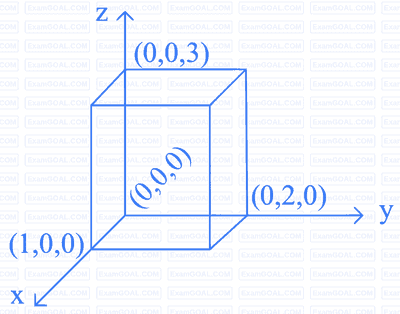
For a charged spherical ball, electrostatic potential inside the ball varies with $$r$$ as $$\mathrm{V}=2ar^2+b$$.
Here, $$a$$ and $$b$$ are constant and r is the distance from the center. The volume charge density inside the ball is $$-\lambda a\varepsilon$$. The value of $$\lambda$$ is ____________.
$$\varepsilon$$ = permittivity of the medium
A point charge $$q_1=4q_0$$ is placed at origin. Another point charge $$q_2=-q_0$$ is placed at $$x=12$$ cm. Charge of proton is $$q_0$$. The proton is placed on $$x$$ axis so that the electrostatic force on the proton is zero. In this situation, the position of the proton from the origin is ___________ cm.
A uniform electric field of 10 N/C is created between two parallel charged plates (as shown in figure). An electron enters the field symmetrically between the plates with a kinetic energy 0.5 eV. The length of each plate is 10 cm. The angle ($$\theta$$) of deviation of the path of electron as it comes out of the field is ___________ (in degree).

A stream of a positively charged particles having $${q \over m} = 2 \times {10^{11}}{C \over {kg}}$$ and velocity $${\overrightarrow v _0} = 3 \times {10^7}\widehat i\,m/s$$ is deflected by an electric field $$1.8\widehat j$$ kV/m. The electric field exists in a region of 10 cm along $$x$$ direction. Due to the electric field, the deflection of the charge particles in the $$y$$ direction is _________ mm.
Two electric dipoles of dipole moments $$1.2 \times 10^{-30} \,\mathrm{Cm}$$ and $$2.4 \times 10^{-30} \,\mathrm{Cm}$$ are placed in two different uniform electric fields of strengths $$5 \times 10^{4} \,\mathrm{NC}^{-1}$$ and $$15 \times 10^{4} \,\mathrm{NC}^{-1}$$ respectively. The ratio of maximum torque experienced by the electric dipoles will be $$\frac{1}{x}$$. The value of $$x$$ is __________.
A long cylindrical volume contains a uniformly distributed charge of density $$\rho \,\mathrm{Cm}^{-3}$$. The electric field inside the cylindrical volume at a distance $$x=\frac{2 \varepsilon_{0}}{\rho} \mathrm{m}$$ from its axis is ________ $$\mathrm{Vm}^{-1}$$.

Three point charges of magnitude $$5 \mu \mathrm{C}, 0.16 \mu \mathrm{C}$$ and $$0.3 \mu \mathrm{C}$$ are located at the vertices $$A, B, C$$ of a right angled triangle whose sides are $$A B=3 \mathrm{~cm}, B C=3 \sqrt{2} \mathrm{~cm}$$ and $$C A=3 \mathrm{~cm}$$ and point $$A$$ is the right angle corner. Charge at point $$\mathrm{A}$$ experiences ____________ $$\mathrm{N}$$ of electrostatic force due to the other two charges.
The volume charge density of a sphere of radius $$6 \mathrm{~m}$$ is $$2 \,\mu \mathrm{C} \,\mathrm{cm}^{-3}$$. The number of lines of force per unit surface area coming out from the surface of the sphere is _______________ $$\times 10^{10} \,\mathrm{NC}^{-1}$$.
[Given : Permittivity of vacuum $$\epsilon_{0}=8.85 \times 10^{-12} \,\mathrm{C}^{2}\, \mathrm{~N}^{-1}-\mathrm{m}^{-2}$$ )
Eight similar drops of mercury are maintained at 12 V each. All these spherical drops combine into a single big drop. The potential energy of bigger drop will be ____________ E. Where E is the potential energy of a single smaller drop.
27 identical drops are charged at 22V each. They combine to form a bigger drop. The potential of the bigger drop will be _____________ V.
D = e$$-$$x sin y $$\widehat i$$ $$-$$ e$$-$$x cos y $$\widehat j$$ + 2z $$\widehat k$$ C/m2
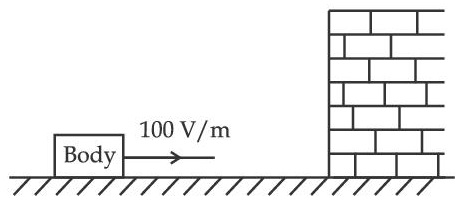
The total force on a 1C point charge, placed at the origin, is x $$\times$$ 103 N.
The value of x, to the nearest integer, is __________. [Take $${1 \over {4\pi {\varepsilon _0}}} = 9 \times {10^9}$$ Nm2/C2]
[Given : $$4\pi {\varepsilon _0} = {1 \over {9 \times {{10}^9}}}$$ SI unit]

passes through the box shown in figure. The
flux of the electric field through surfaces ABCD
and BCGF are marked as $${\phi _I}$$ and $${\phi _{II}}$$
respectively. The difference between $$\left( {{\phi _I} - {\phi _{II}}} \right)$$ is (in Nm2/C) _______.
